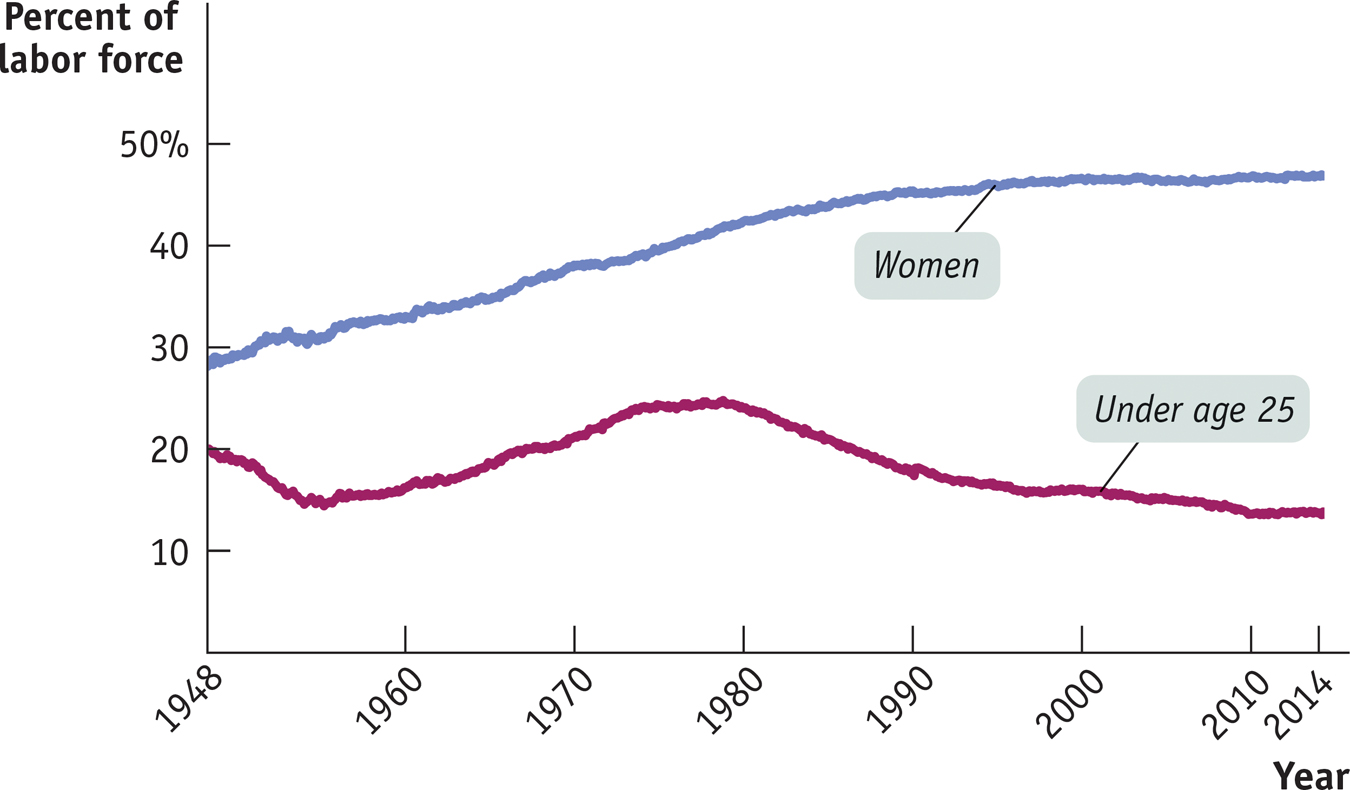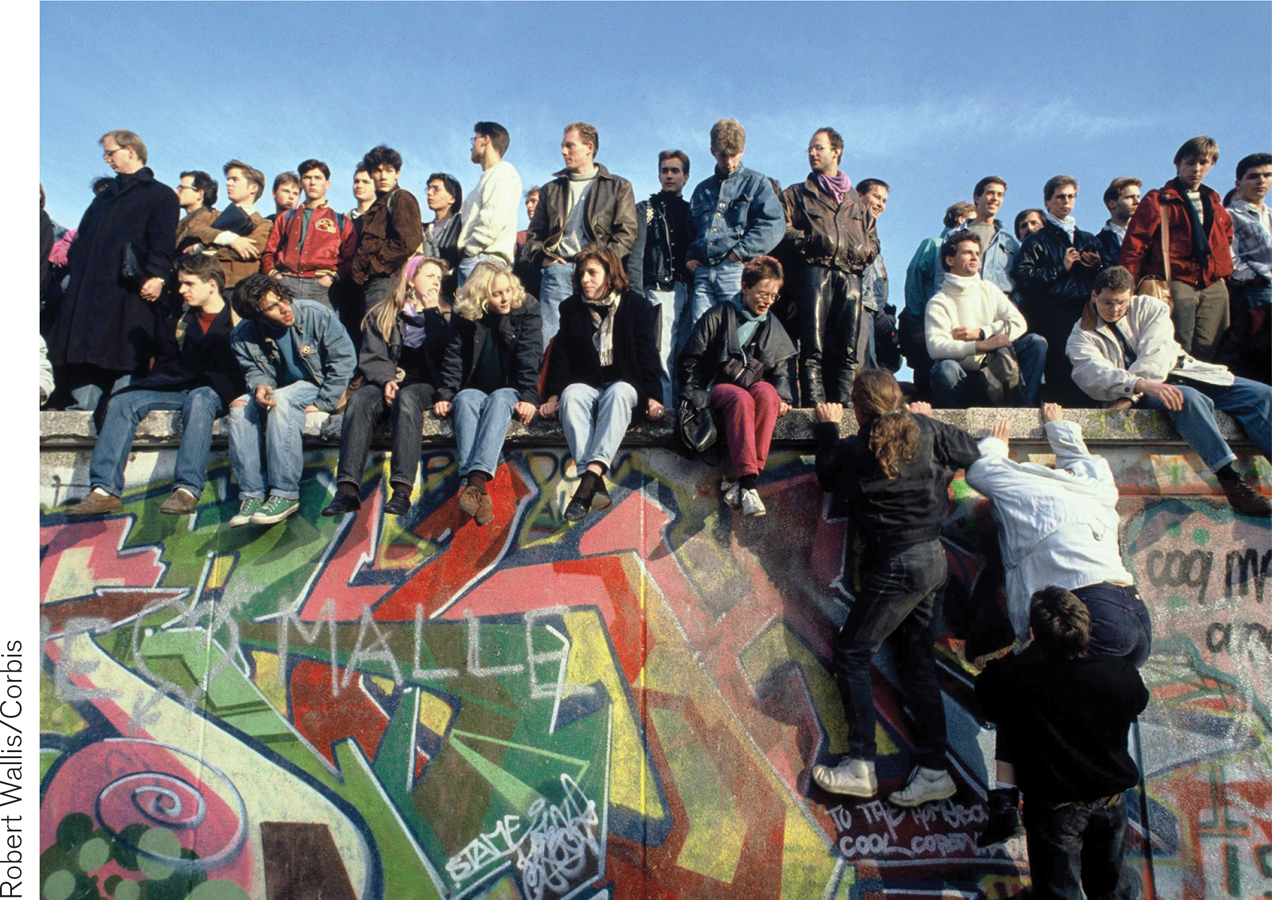Changes in the Natural Rate of Unemployment
Private-
What causes the natural rate of unemployment to change? The most important factors are changes in labor force characteristics, changes in labor market institutions, and changes in government policies. Let’s look briefly at each factor.
Changes in Labor Force Characteristics In 2007 the rate of unemployment in the United States was 4.6%. Young workers, however, had much higher unemployment rates: 15.7% for teenagers and 8.2% for workers aged 20 to 24. Workers aged 25 to 54 had an unemployment rate of only 3.7%.
In general, unemployment rates tend to be lower for experienced than for inexperienced workers. Because experienced workers tend to stay in a given job longer than do inexperienced ones, they have lower frictional unemployment. Also, because older workers are more likely than young workers to be family breadwinners, they have a stronger incentive to find and keep jobs.
One reason the natural rate of unemployment rose during the 1970s was a large rise in the number of new workers—
8-11
The Changing Makeup of the U.S. Labor Force, 1948–

Changes in Labor Market Institutions As we pointed out earlier, unions that negotiate wages above the equilibrium level can be a source of structural unemployment. Some economists believe that the high natural rate of unemployment in Europe, discussed in the Global Comparison, is caused, in part, by strong labor unions. In the United States, a sharp fall in union membership after 1980 may have been one reason the natural rate of unemployment fell between the 1970s and the 1990s.
Other institutional changes may also be at work. For example, some labor economists believe that temporary employment agencies, which have proliferated in recent years, have reduced frictional unemployment by helping match workers to jobs. Furthermore, as discussed in the Business Case at the end of the chapter, websites such as Elance-
Technological change, coupled with labor market institutions, can also affect the natural rate of unemployment. Technological change tends to increase the demand for skilled workers who are familiar with the relevant technology and reduce the demand for unskilled workers. Economic theory predicts that wages should increase for skilled workers and decrease for unskilled workers as technology advances. But if wages for unskilled workers cannot go down—
Changes in Government Policies A high minimum wage can cause structural unemployment. Generous unemployment benefits can increase both structural and frictional unemployment. So government policies intended to help workers can have the undesirable side effect of raising the natural rate of unemployment.
Some government policies, however, may reduce the natural rate. Two examples are job training and employment subsidies. Job-
!worldview! ECONOMICS in Action: Structural Unemployment in East Germany
Structural Unemployment in East Germany
In one of the most dramatic events in world history, a spontaneous popular uprising in 1989 overthrew the communist dictatorship in East Germany. Citizens quickly tore down the wall that had divided Berlin, and in short order East and West Germany united into one democratic nation.
Then the trouble started.

After reunification, employment in East Germany plunged and the unemployment rate soared. This high unemployment rate has gradually come down, but remains well above the rate in the rest of Germany. In late 2014 the unemployment rate in what was formerly East Germany was more than 9%, compared with 5.6% in the former West Germany. Other parts of formerly communist Eastern Europe have done much better. For example, the Czech Republic, which was often cited along with East Germany as a relatively successful communist economy, had an unemployment rate of only 5.7% in October 2014. What went wrong in East Germany?
The answer is that, through nobody’s fault, East Germany found itself suffering from severe structural unemployment. When Germany was reunified, it became clear that workers in East Germany were much less productive than their cousins in the west. Yet unions initially demanded and received wage rates equal to those in West Germany. These wage rates have been slow to come down because East German workers objected to being treated as inferior to their West German counterparts. Meanwhile, productivity in the former East Germany remains well below West German levels, in part because of decades of misguided investment under the former dictatorship. The result has been a persistently large mismatch between the number of workers demanded and the number of those seeking jobs, and persistently high structural unemployment in the former East Germany.
Quick Review
Frictional unemployment occurs because unemployed workers engage in job search, making some amount of unemployment inevitable.
A variety of factors—
minimum wages, unions, efficiency wages, the side effects of government policies such as unemployment benefits, and mismatches between employees and employers— lead to structural unemployment. Frictional plus structural unemployment equals natural unemployment, yielding a natural rate of unemployment. In contrast, cyclical unemployment changes with the business cycle. Actual unemployment is equal to the sum of natural unemployment and cyclical unemployment.
The natural rate of unemployment can shift over time, due to changes in labor force characteristics and institutions. Government policies designed to help workers are believed to be one reason for high natural rates of unemployment in Europe.
8-2
Question 8.4
Explain the following statements.
Frictional unemployment is higher when the pace of technological advance quickens.
When the pace of technological advance quickens, there will be higher rates of job creation and destruction as old industries disappear and new ones emerge. As a result, frictional unemployment will be higher as workers leave jobs in declining industries in search of jobs in expanding industries.
Structural unemployment is higher when the pace of technological advance quickens.
When the pace of technological advance quickens, there will be greater mismatch between the skills employees have and the skills employers are looking for, leading to higher structural unemployment.
Frictional unemployment accounts for a larger share of total unemployment when the unemployment rate is low.
When the unemployment rate is low, frictional unemployment will account for a larger share of total unemployment because other sources of unemployment will be diminished. So the share of total unemployment composed of the frictionally unemployed will rise.
Question 8.5
Why does collective bargaining have the same general effect on unemployment as a minimum wage? Illustrate your answer with a diagram.
A binding minimum wage represents a price floor below which wages cannot fall. As a result, actual wages cannot move toward equilibrium. So a minimum wage causes the quantity of labor supplied to exceed the quantity of labor demanded. Because this surplus of labor reflects unemployed workers, it affects the unemployment rate. Collective bargaining has a similar effect—unions are able to raise the wage above the equilibrium level to a level like WU in the accompanying diagram. This will act like a minimum wage by causing the number of job-seekers to be larger than the number of workers firms are willing to hire. Collective bargaining causes the unemployment rate to be higher than it otherwise would be, as shown in the accompanying diagram.

Question 8.6
Suppose that at the peak of the business cycle the United States dramatically increases benefits for unemployed workers. Explain what will happen to the natural rate of unemployment.
An increase in unemployment benefits at the peak of the business cycle reduces the cost to individuals of being unemployed, causing them to spend more time searching for new jobs. So the natural rate of unemployment would increase.
Solutions appear at back of book.